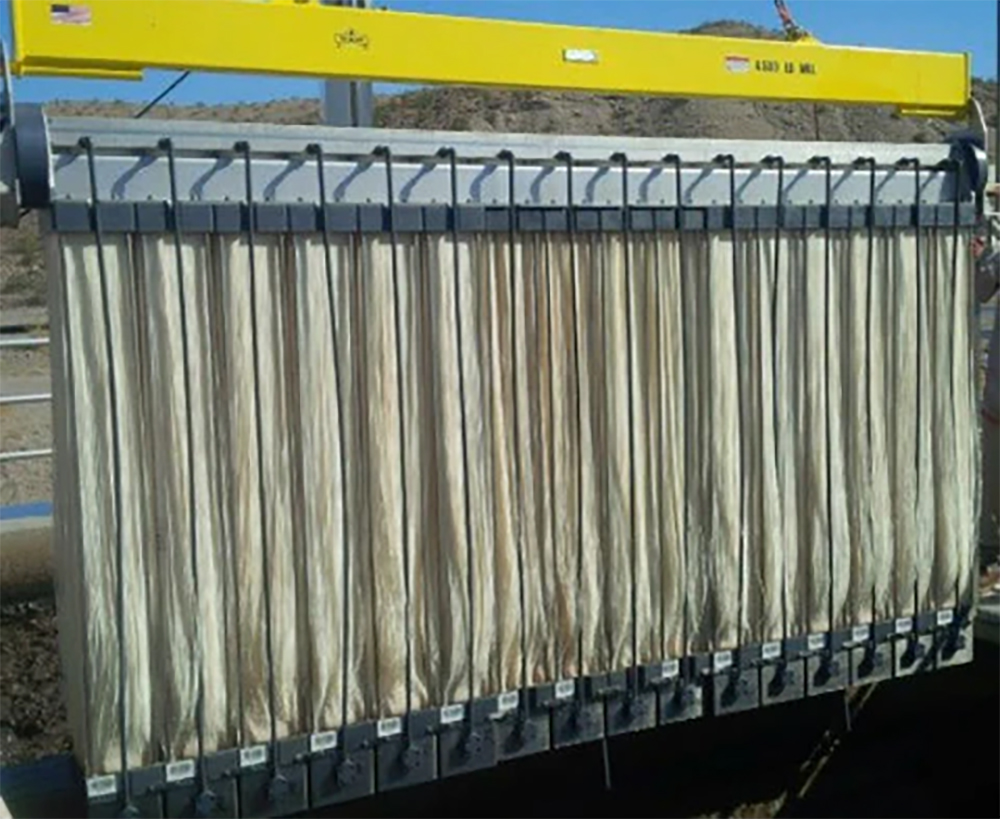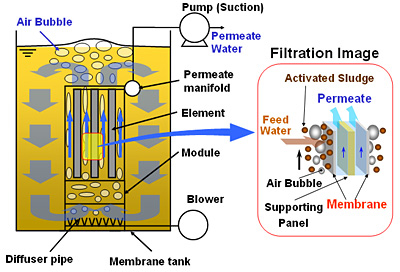How Membrane Bioreactor Contributes to the Reduction of Energy Consumption in Water Treatment
How Membrane Bioreactor Contributes to the Reduction of Energy Consumption in Water Treatment
Blog Article
Membrane Layer Bioreactors Described: Reliable Solutions for Tidy Water
Membrane bioreactors (MBRs) have arised as an advanced option for addressing the pushing obstacles of wastewater therapy - Membrane Bioreactor. By incorporating organic procedures with sophisticated membrane filtering, MBRs not only enhance the top quality of treated water however likewise lower the spatial demands of therapy facilities.

What Are Membrane Layer Bioreactors?
Membrane layer bioreactors (MBRs) are advanced wastewater treatment systems that integrate organic deterioration procedures with membrane filtration technology. This combination permits the effective elimination of pollutants from water, making MBRs a recommended selection in different applications, consisting of municipal wastewater treatment and commercial effluent administration.

Among the vital benefits of MBRs is their ability to produce high-quality effluent, commonly ideal for reuse in watering or industrial processes. Additionally, MBRs require a smaller sized impact contrasted to standard therapy systems, making them perfect for metropolitan settings where area might be limited.
Additionally, MBRs can effectively deal with differing influent lots and are much less at risk to the impacts of poisonous shocks. These characteristics add to their growing appeal as a lasting remedy for resolving the boosting need for clean water while lessening ecological influences.
Exactly How Membrane Bioreactors Work
While the procedure of membrane bioreactors (MBRs) may seem facility, it fundamentally rotates around the harmony in between organic processes and membrane filtration. MBRs incorporate an organic treatment process, typically turned on sludge, with a membrane layer separation unit to deal with wastewater efficiently.
In an MBR system, wastewater is first presented right into a bioreactor where microorganisms deteriorate raw material and various other contaminants. The organic task reduces the concentration of toxins while advertising the growth of biomass. Following this biological treatment, the combined liquor undergoes membrane layer filtering, which can be microfiltration or ultrafiltration, relying on the wanted effluent high quality.
The membranes work as a physical barrier, permitting water and small solutes to pass while retaining put on hold solids and larger particles. This makes it possible for the system to keep a high concentration of biomass within the reactor, improving the treatment effectiveness.
Furthermore, the constant splitting up of cured water from the biomass assists in a portable design and reduces the impact of the therapy facility. In general, the mix of organic deterioration and membrane filtering in MBRs causes reliable and effective wastewater treatment, making certain high-quality effluent ideal for numerous applications.
Advantages of MBR Modern Technology
Among the crucial advantages of membrane bioreactor (MBR) modern technology is its ability to create top notch effluent with a dramatically lowered footprint compared to standard wastewater treatment approaches. MBR systems successfully combine organic therapy and membrane layer purification, causing premium removal of pollutants, consisting of suspended solids, pathogens, and raw material. This ability causes effluent that commonly satisfies or goes beyond rigorous governing requirements for reuse and discharge.
In addition, MBR innovation enables for higher biomass concentrations, which enhances the therapy efficiency and decreases the required reactor quantity. This compact layout is specifically valuable in urban locations where room is restricted. The functional versatility of MBR systems likewise suggests they can adjust to varying influent top qualities and flow rates, making them ideal for a vast array of applications.
In addition, the reduced sludge production connected with MBR procedures adds to decrease operational and maintenance costs. The membrane layers act as a physical barrier, lessening the danger of obstructing and enabling longer operational durations in between cleansing. On the whole, the benefits of MBR technology make it an eye-catching remedy for sustainable wastewater therapy, addressing both environmental concerns and the need for effective resource management.
Applications of Membrane Bioreactors
With their adaptability and effectiveness, membrane layer bioreactors (MBRs) find applications across numerous sectors, consisting of municipal wastewater treatment, commercial processes, and even water recovery. In metropolitan setups, MBRs offer a small service for treating wastewater, properly getting rid of contaminants while concurrently creating premium effluent that meets stringent regulatory criteria. This makes them especially suitable for locations with restricted space.
In industrial applications, MBR modern technology is used for dealing with process water, particularly in markets such as food and drink, drugs, and petrochemicals. These sectors take advantage of MBRs' ability to take care of high organic lots and their efficiency in recuperating valuable sources from wastewater, such as nutrients and water.
Furthermore, MBRs play a vital function in water improvement campaigns, allowing the reuse of dealt with wastewater for watering, commercial procedures, or also as safe and clean water after additional therapy (Membrane Bioreactor). Their effectiveness in removing virus and pollutants makes them a reliable option for making certain water quality in various reuse applications
Future of Water Therapy Solutions
The future of water therapy remedies is poised for transformative advancements driven by technical development and enhancing ecological recognition. As international water shortage becomes a pushing issue, new techniques, including membrane bioreactor (MBR) systems, are readied to play an essential function in enhancing the effectiveness and sustainability of water therapy processes.
Emerging innovations such as expert system and artificial intelligence are anticipated to optimize therapy procedures, permitting real-time tracking and anticipating upkeep. This will enhance the total news reliability and performance of water therapy facilities. In addition, improvements in membrane layer products, such as graphene and nanofiltration, guarantee to enhance permeation rates and lower fouling, causing reduced energy usage and functional prices.
In addition, the integration of sustainable power sources into water treatment plants will add to greener methods. The round economic situation version will certainly also get grip, encouraging the recuperation of beneficial resources from wastewater, such as nutrients and energy.
Verdict

Membrane layer bioreactors (MBRs) have actually arised as a sophisticated remedy for resolving the pushing difficulties of wastewater therapy. By incorporating organic processes with sophisticated best site membrane filtration, MBRs discover here not only boost the quality of cured water however also minimize the spatial demands of therapy centers.One of the essential advantages of membrane layer bioreactor (MBR) innovation is its ability to generate top quality effluent with a significantly reduced footprint compared to traditional wastewater therapy approaches.With their adaptability and effectiveness, membrane layer bioreactors (MBRs) discover applications throughout numerous sectors, including metropolitan wastewater treatment, commercial procedures, and even water reclamation.In conclusion, membrane bioreactors stand for a substantial improvement in wastewater therapy modern technology, incorporating organic procedures with effective membrane filtration to produce top quality effluent.
Report this page